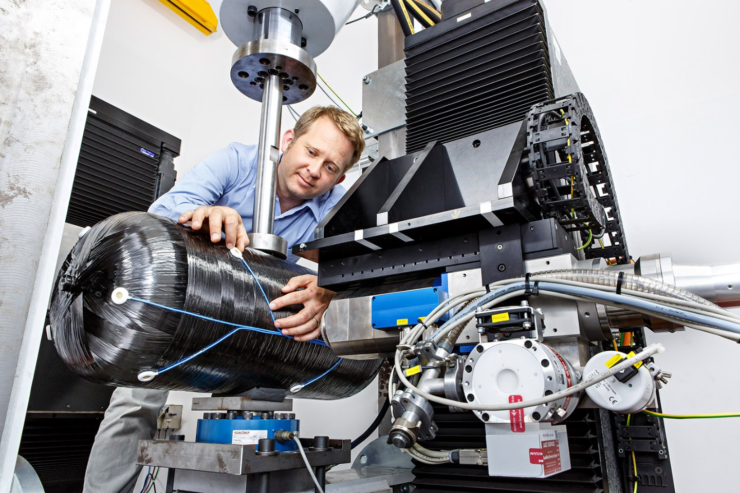Safe tanks for hydrogen vehicles.
Hydrogen is a beacon of hope for the successful transition of the energy and mobility sectors. However, the gas is also highly explosive, and strict safety precautions are needed if hydrogen is to be used safely. The latest fuel cell vehicles carry hydrogen in gaseous form in pressurized tanks. These core elements of the H2 drive system must remain safe even under maximum operational loads.
To prevent hazardous situations from occurring, regular maintenance of the high-pressure storage systems is mandatory. However, the tank inspection that is currently required every two years consists merely of an external visual inspection. Damage inside the tank cannot be detected using this conventional inspection method.
In the joint research project HyMon, researchers from the Fraunhofer Institute for Structural Durability and System Reliability LBF are working with partners to develop a sensor-based on-board structural monitoring system that will enable continuous surveillance of the H2 pressure tanks, thereby ensuring a high level of safety for hydrogen vehicles.
🔥 What about we co-host a webinar? Let's educate, captivate, and convert the hydrogen economy!
Hydrogen Central is the global go-to online magazine for the hydrogen economy, we can help you host impactful webinars that become a global reference on your topic and are an evergreen source of leads. Click here to request more details
Hydrogen is currently stored in gaseous form under high pressure of up to 700 bar in tanks made of fiber-reinforced composites (FRC). Compared to metal tanks, these are ideal for use in the mobility and transport sector due to their low mass. For safety reasons, the H2 pressure tanks are subjected to extensive testing before they are used for the first time to ensure safe operation throughout their service life.
It must also be ensured that the tank will maintain its integrity in the face of recurring stresses caused by refueling and withdrawal of hydrogen or in the event of damage (e.g., rear-end collision). The visual inspections currently specified to check for external damage to the tank cannot do this. As an alternative, damage can be detected by continuously monitoring the pressure vessel — a process known as structural health monitoring or SHM for short.
As part of the HyMon project (see box), researchers at Fraunhofer LBF in Darmstadt are developing a dedicated intelligent system for continuous status monitoring of hydrogen tanks, in close cooperation with partners. One purpose of this on-board structural monitoring system, consisting of suitable sensors and evaluation electronics, is to provide data for service and repair.
Johannes Käsgen, a scientist at Fraunhofer LBF said:
To give an example, our technology provides inspectors from the German technical inspection associations (TÜV) with objective information about the stresses on the tank after an accident, enabling them to decide objectively whether it can be reused or needs to be replaced.
Another function is to help reduce maintenance costs and ensure that tanks are used safely throughout their entire service life.
Acoustic emission and strain sensors detect damage in the tank
The research work focuses on acoustic emission sensors. If a single carbon fiber tears in the pressure tank, a sound wave is generated that travels through the fibers. The sensors detect this high-frequency sound wave, which allows them to determine the number of broken fibers.
“Special load cases, such as rear-end collisions, can damage local areas of the tanks, causing a lot of fibers to break in a very short space of time,” Käsgen explains. “The measurement signals are processed by evaluation electronics to provide information about the health status of the tank.” The requisite algorithms and methods for detecting fiber breaks are being developed at Fraunhofer LBF. These include, for example, sound wave frequency analyses.
“Sensors on the tank pick up the high-frequency sound waves when a fiber breaks, and the algorithms detect the broken fibers, which are then counted. If the rate of fiber breakage suddenly increases, this is an indication that the hydrogen tank is at the end of its useful life,” says the researcher, summing up the process.
Continuous on-board structural monitoring guarantees an increased level of safety for hydrogen vehicles, as potential damage can be assessed even in the case of minor impacts, such as hitting a bollard, and the remaining service life of the tank can be estimated. What’s more, this comprehensive quality assurance approach means that unnecessary replacement of hydrogen tanks can be avoided.
In addition to the acoustic emission sensors, fiber-optic strain sensors are also integrated into the tanks. These consist of light-conducting glass fibers that have fiber Bragg grating sensors integrated into them. The glass fibers are enveloped into the FRC layer of the tank during manufacturing or applied to the surface afterwards to enable continuous or periodic automated monitoring of strains at the hydrogen tank.
Unlike conventional strain sensors, these glass fibers are particularly suitable for monitoring carbon fiber-reinforced plastics due to their resilience to high material strains and load cycles. The measurement data from the strain sensors is used firstly to verify the calculation models of the pressure tanks and secondly to gain insight into how the material behavior changes throughout the tank’s service life in order to draw conclusions about the fatigue state of the material.
Complete system put to the test in the test vehicle
The first stage of the testing process is to produce various types of damage such as fiber breaks, matrix breaks or delaminations in the test rig at Fraunhofer LBF using sensor-equipped carbon fiber flat specimen. The damage signals are recorded with the sensors.
Next, an assessment is made as to whether the sensors are capable of recording the signals in sufficient quality and whether the algorithms can classify the damage mechanisms correctly on the basis of the signals. In the next step, the entire sensor system is tested on thin-walled tank models and then on high-pressure hydrogen tanks, which are subjected to cyclical stresses under internal pressure until failure occurs.
The research teams are investigating how many sensors are required for structural monitoring, where they need to be positioned, and which adhesives are most suitable for attaching them to the hydrogen tank. Finally, a test vehicle is fitted with sensors and on-board structural monitoring and validated by combining a virtual crash with a real-life test setup. The project partners’ objective is to develop the complete system into a standard status monitoring system for the future.
READ the latest news shaping the hydrogen market at Hydrogen Central
Safe tanks for hydrogen vehicles, September 1, 2023









2 comments